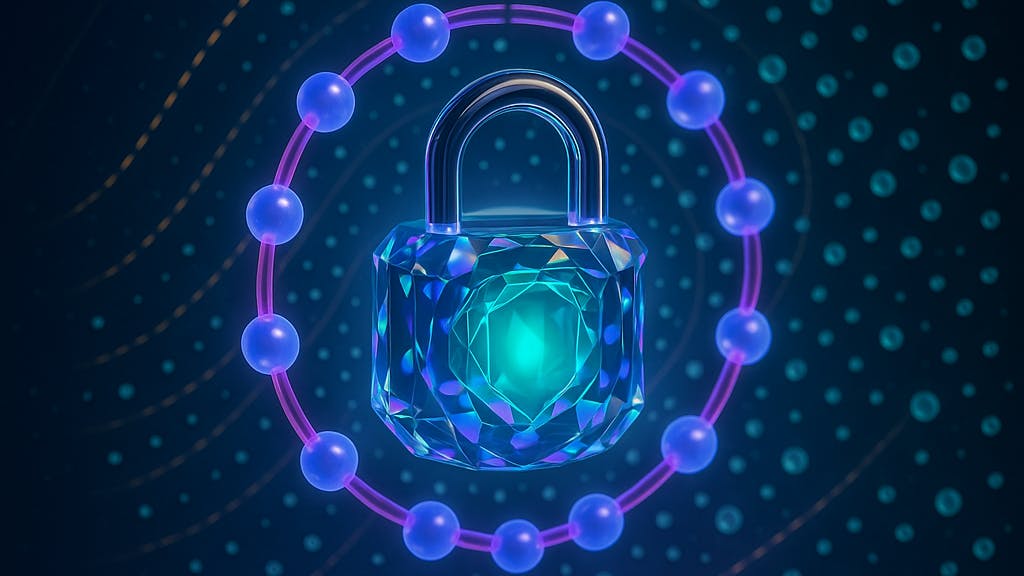Over the past two decades, most of our online experience has been controlled by a handful of giant platforms whose proprietary feeds, ads, and moderation policies shape what we see and say. A growing “Great Decentralization”, with users fleeing X (Twitter) for federated networks like Mastodon and Bluesky shows that people increasingly want services where they can move their data, choose their own rules, and avoid Big Tech lock-in. These experiments signal the contours of a post-platform internet: an ecosystem built on open protocols, peer-to-peer infrastructure, and community-run servers rather than corporate silos.
Yet this decentralized future is meeting another another major technological inflection point. Large-scale, error-corrected quantum computers are edging closer: Google researchers recently cut resource estimates for breaking RSA-2048 to under a million noisy qubits, while national security agencies on both sides of the Atlantic are telling operators to migrate to quantum-resistant algorithms no later than 2035. Attackers already practice “harvest-now, decrypt-later,” collecting encrypted traffic today in hopes of decoding it once Shor’s algorithm becomes practical.
Unless we add post-quantum security measures to the new, user-controlled web now, future decentralized networks could become easy targets for quantum-powered eavesdroppers. This would replace Big Tech’s controlled environments with a major surveillance risk on Q-Day.
What Is a Post-Platform Internet?
A post-platform internet is an environment where data, identity, and computation live outside of any single company’s control. Three ideas anchor it: decentralization (no single point of control), portability (users can freely move their data and social connections), and sovereignty (individuals or communities, not corporations, decide who gets access). The Post-Platforms Foundation frames this as “decoupling data from platforms,” while recent research on Web3 governance argues that shifting power to the edge is essential for meaningful digital self-determination.
Key building blocks
|
Layer |
What it does |
Post-platform example |
|---|---|---|
|
Peer-to-peer protocols |
Remove central servers; content is fetched from whoever has it |
IPFS is prioritising in-browser retrieval and lightweight clients for 2025 to cut reliance on gateway operators.([discuss.ipfs.tech][3]) |
|
DePIN (Decentralised Physical Infrastructure Networks) |
Crowd-owns the hardware layer connectivity, storage, sensors through token incentives |
Helium, Hivemapper, Render and others show how communities can build 5G, mapping and GPU grids without telecom giants. |
|
Federated & composable apps |
Servers talk via open standards so users can hop instances without losing their social graph |
ActivityPub powers thousands of Mastodon, PeerTube and Pixelfed servers; Bluesky’s AT Protocol offers a similar plug-and-play feed model. |
Real-world signals of the future: It’s already happening.
- Bluesky crossed 33 million registered accounts by March 2025 and is still adding roughly one user per second.
- Mastodon operates over 9,500 independent servers hosting 8 million+ users, proof that federation scales.
- Helium has grown into a global wireless mesh with 350,000 nodes, showing that grassroots hardware incentives can outperform many established companies.
Together, these ingredients sketch a web where switching providers is as easy as changing e-mail hosts, your connectivity is community-run, and no single firm can unilaterally rewrite the rules of participation.
The Quantum Threat Landscape
Peter Shor’s 1994 breakthrough showed that a sufficiently large, error-corrected quantum computer can factor integers and solve discrete-log problems in polynomial time, instantly toppling the RSA and elliptic-curve cryptography that anchor most of today’s TLS handshakes, PGP keys, and blockchain signatures. Recent work from Google Quantum AI cut the resources needed to crack a 2048-bit RSA key from the billions of physical qubits once assumed to fewer than one million noisy qubits and under a week of runtime, thanks to new circuit-compression and error-mitigation techniques.
While Shor targets public-key systems, Lov Grover’s search algorithm gives a quadratic boost against symmetric ciphers. In practice that halves effective key strength, meaning AES-256 would only deliver about 128 bits of post-quantum security still serviceable, but only if implementers double key lengths and avoid hash sizes below 256 bits.
The narrowing distance between theory and engineering fuels a tactic intelligence agencies call “harvest now, decrypt later.” Adversaries tap fibre backbones, copy VPN handshakes, or crawl blockchain traffic today, confident they can replay the ciphertext against a future quantum machine. U.S. CISA guidance urges organizations to inventory any data that must stay secret past 2035, because those archives are already being siphoned for eventual decryption.
How soon could a cryptographically relevant quantum computer materialize? Government road-maps and corporate timelines are converging. IBM’s new data-center in Poughkeepsie is slated to test the 10-kilo-qubit Loon processor in 2025 as a stepping-stone toward fault-tolerant machines later this decade, while IonQ’s accelerated plan targets 20 000 physical qubits by 2028 and tens of thousands of logical qubits by 2030. NIST’s draft transition report therefore treats 2035 as a hard deadline: after that year U.S. federal systems may not use classical crypto at all, underscoring that the window to migrate is closing fast.
In short, the same decentralized applications that promise freedom from platform lock-in risk becoming read-only archives for tomorrow’s quantum adversaries unless they harden their cryptography before Q-Day arrives.
Post-Quantum Cryptography Primer
The list of quantum-resistant algorithms is sorted by the mathematical problems they use. Lattice schemes, like CRYSTALS-Kyber for key encapsulation and CRYSTALS-Dilithium or Falcon for digital signatures, rely on the difficulty of finding short vectors in high-dimensional lattices. Their arithmetic is suitable for constant-time software, and importantly for web traffic, their public keys remain in the 1-2 kB range. For instance, Kyber-768 sends a 1,184-byte public key, and Dilithium-3 creates 2,701-byte signatures. Hash-based signatures, such as SPHINCS+, derive security from well-known primitives like SHA-2 or SHA-3. They avoid complex algebra but are larger in size; even the smallest SPHINCS+ signature is about 8 kB and can go up to 40 kB for the highest security levels. Code-based cryptography uses disguised error-correcting codes; Classic McEliece is a key example, but its public key, around 260 kB in the commonly used level-1 parameter set, is much larger than lattice keys. Multivariate quadratic (MQ) schemes once seemed promising, but the main candidate, Rainbow, was completely broken in 2022, showing that some families still have unresolved cryptanalytic issues.
NIST turned these research lines into deployable standards in August 2024, publishing FIPS 203 (Kyber), FIPS 204 (Dilithium) and FIPS 205 (SPHINCS+). A fourth-round evaluation selected HQC, a code-based key-encapsulation mechanism, for eventual standardization in March 2025 and continues to study Classic McEliece, BIKE and others; final profiles for Falcon and the remaining KEM are slated for release during 2025-26 alongside reference test vectors and conformance tools.
Choosing among these options involves a trade-off between bandwidth, runtime, and implementation complexity. Lattice algorithms generally offer the best balance: their keys and ciphertexts are small enough to fit within a typical network packet, and software implementations require only 2–3 times the CPU cycles of classical ECDH on standard hardware. Hash-based signatures shift most costs to bandwidth and verification time but offer a secure foundation based on existing hash functions, making them ideal for firmware updates that can handle large payloads. Code-based systems take a different approach: they have huge public keys but small ciphertexts and fast decapsulation, which is perfect for environments like satellite links where keys are sent once and used for years. Across all these options, ensuring side-channel resistance and constant-time coding are challenging engineering tasks, highlighting the importance of NIST’s upcoming implementation guidelines and test suites, which will be as crucial as the mathematics itself.
Designing Privacy for the Post-Quantum, Post-Platform Web
The first design goal is to replace the current Diffie-Hellman or Curve25519 “first contact” with hybrid handshakes that combine classical and lattice algorithms. Cloudflare’s edge now uses TLS 1.3 connections where X25519 is paired with ML-KEM (Kyber), already protecting “nearly two percent of all traffic.” They expect this to reach double digits by the end of 2024. Messaging systems are advancing even faster: Apple’s new PQ3 protocol for iMessage combines Kyber with three ongoing ratchets, ensuring every new key is pre-quantum-armored. This eliminates the “harvest-now, decrypt-later” risk for billions of devices once iOS 17.4 is widely adopted. The approach is clear: maintain the elliptic curve exchange for backward compatibility, add Kyber (or another NIST KEM) alongside it, and derive the session secret from both. If either part remains secure, so does the confidentiality.
End-to-end privacy relies on proofs instead of trust, and the community is moving away from a decade of SNARKs built on elliptic-curve pairings. Hash-centric zk-STARK systems are already safe from quantum attacks because their security depends on the collision resistance of functions like SHA-256. Grover’s algorithm only doubles the hash length, so 256-bit digests remain secure. Research groups are now adding lattice-based polynomial commitments to Plonk-style protocols, allowing developers to maintain concise proofs without relying on elliptic curves. The practical advice is to use STARK-compatible stacks for new applications and consider current pairing-based rollups as technical debt that should be replaced before Q-Day.
Identity is a moving target: keys expand from 32-byte Ed25519 blobs to larger Dilithium or SPHINCS+ materials, which require frequent rotation policies. The W3C did:key method allows controllers to create a new DID from any public key and update verification material without needing a global registry. Post-platform wallets can take advantage of this by issuing DIDs with short validity periods (like one month), embedding expiry metadata in Verifiable Credentials, and switching to a new ML-DSA key pair before an attacker can exploit side-channel or storage attacks on a large lattice key. Since DIDs are URI-addressable, rotating keys doesn’t disrupt application references. The content points to the identifier, which then resolves to the current quantum-safe document.
Finally, traffic-shaping layers need to evolve. The Nym mixnet has released a 2025 roadmap that plans to use Kyber-based key exchange in every hop of its Sphinx packet format. This will ensure that metadata-private routing remains secure even when quantum decryption becomes possible. Onion-routing research is also progressing: Tor developers have proposed combining the NTor handshake with NewHope, a lattice KEM, to make circuits quantum-resistant with only a small increase in handshake size. Since mixnets and onion layers already handle latency, the additional kilobytes of lattice data are manageable. The real challenge lies in dealing with hardware security modules and exit relays that currently can’t store or process larger keys.
These developments demonstrate that the post-platform web can be both privacy-preserving and quantum-resilient. However, this is only possible if developers integrate post-quantum features into every layer, from the first TLS packet to the last mixnet hop, and consider key changes as a regular part of digital life, not as an unusual event.
Case Studies in the Wild
The theory of “quantum-safe decentralization” is already colliding with practice. Four very different projects: secure messaging, mix-nets, off-planet DePIN, and the social-web Fediverse show how far implementation experiments have progressed and where the roadblocks still lie.
Matrix: hybrid Kyber + Dilithium inside a double-ratchet prototype
Matrix’s end-to-end-encrypted ecosystem has spent the past two years rebuilding its crypto stack in Rust. That work culminated in the Element-R rollout, whose mandate explicitly lists “post-quantum encryption” as a priority and routes all clients through the new matrix-rust-sdk-crypto core. On the code side, a pull-request to the vodozemac library wires in the PQXDH handshake: X3DH is extended with ML-KEM/Kyber for key encapsulation and a plan to upgrade device-identity signatures to ML-DSA/Dilithium once the IETF signs off. Early lab tests show the enlarged key bundles add roughly 3 kB to the first message but leave ratchet throughput unaffected; the team is now fuzz-testing protobuf encodings for side-channel leaks.
Nym: a lattice-based future for mix-net privacy
Nym’s Sphinx packets already use ChaCha20/Poly1305 over a SURB-style mix-net. However, the project roadmap published in April 2025 outlines a two-step migration: first, add a Kyber768/ChaCha20 hybrid for relay handshakes in version 2, and then replace the RSA-based SURB signature with Dilithium once FIPS 204 is stable. Benchmarks on a 1 GHz ARM core show that Kyber encapsulation adds about 0.4 ms per hop, which is negligible compared to network latency. The more challenging task is redesigning the single-use reply block to keep packet headers under 1.5 kB after adding a Dilithium signature. This constraint is necessary to fit within Tor-compatible 512-cell circuits.
Satellite DePIN: pushing PQC to the link layer
Spacecoin’s “Celestial Chain” DePIN has already launched its first CubeSat into low Earth orbit (LEO), but link-layer security still depends on AES keys exchanged via an ECC handshake. The community highlights two proofs-of-concept that suggest a post-quantum upgrade is feasible. First, QuSecure demonstrated a Kyber-protected Starlink link in March 2023, streaming encrypted traffic end-to-end through SpaceX ground stations. Second, researchers on the SpooQy-1 nanosatellite uploaded firmware that completed a full Kyber-512 authenticated key exchange over a 436 MHz UHF channel, using an AVR32 microcontroller with only 32 kB of RAM. These results show that lattice-based KEMs can fit inside SWaP-constrained radios, paving the way for DePIN operators to adopt ML-KEM before launching any large-scale constellations.
Fediverse pilots: ActivityPub with Dilithium signatures
While Mastodon and other ActivityPub servers still use RSA/HTTP-Signatures by default, developers in the SocialHub community are working on a FEP (Fediverse Enhancement Proposal) to clarify signature processing and accommodate quantum-safe algorithms. Experimental branches are using Paul Miller’s noble-post-quantum JavaScript library, which includes ML-KEM and Dilithium primitives. The demo patches replace rsa-sha256 headers with dilithium-sha512 on local test instances to assess bandwidth impact. Packet captures indicate that a one-to-many “boost” generates about 14 kB of extra header data per remote server. This is large, but still smaller than typical image attachment sizes. No mainline Fediverse project has adopted this change yet, but the trials show the protocol works and highlight the main challenge: spreading new OID constants across thousands of independently-run instances.
These examples show a pattern: small, focused experiments are safely testing post-quantum features in real decentralized systems. While performance issues can be measured and managed, governance and version differences are more challenging. The lesson for developers is clear; begin tracking and measuring now, as the engineering focus is shifting from “Can we do this?” to “How quickly can we implement this before the risk of decrypting later becomes a problem?”
Implementation Challenges
A post-platform web can’t rely on the powerful servers of Big Tech; much of it operates on single-board computers, phones, and embedded routers. Tests on a 1.5 GHz Raspberry Pi 4 show that post-quantum handshakes already use significant processing power. Even the fastest lattice pair, Kyber + Dilithium, makes key generation, encapsulation, and decapsulation much slower than on a desktop. Overall, TLS handshake throughput on the Pi is 5–10 times slower than the same code on an x86 workstation. An IETF draft for IoT vendors highlights this issue, noting that larger keys “exhaust memory, storage, and battery budgets,” leading to trade-offs like seed-only private-key storage, which adds computing overhead every time a key is derived.
Even when the CPU budget exists, traffic still has to cross a long tail of intermediaries. Cloudflare’s early hybrid-TLS rollout revealed that some middleboxes mis-parse the larger ClientHello, silently dropping connections; other stacks fail because Kyber changed wire formats between drafts. These quirks make staged, hybrid deployments mandatory, yet they also slow user migration: if one hop in a federated service balks at a PQ extension, everyone has to fall back to classical crypto for the sake of reachability.
Hardware introduces its own delays in the supply chain. Certificate Authorities admit they “don’t currently have compatible Hardware Security Modules to provide post-quantum-safe certificates,” which means root keys are still tied to RSA while the public web advances. PKCS#11 vendors like EJBCA can offer “early support for quantum-safe algorithms,” but only through next-generation modules that many operators haven’t budgeted for or evaluated yet. Until ready-made HSMs, TPMs, SIMs, and secure enclaves support lattice and hash-based methods, every on-chain wallet or self-hosted server is vulnerable to hardware upgrade cycles, not just Git commits.
Finally, the social aspect of a decentralized ecosystem increases coordination costs. Researchers studying the Fediverse, which includes over 29,000 independent servers, note significant differences in moderation teams, funding, and technical expertise. They warn that “multi-voiced, self-governing” networks find it difficult to agree on even small protocol changes. NIST’s 2025 white paper on crypto agility states that any transition to quantum technology is “costly, raises interoperability issues, and disrupts operations,” especially since each community has its own release schedule and threat model. In practice, this means some instances will switch to post-quantum (PQ) cryptography years before others, forcing bridges and relays to manage dual cryptographic systems indefinitely.
The combination of these challenges; CPU limits, legacy middleboxes, incomplete hardware support, and polycentric governance, explains why the “easy part” (designing strong algorithms) now gives way to the hard slog of getting them to run, everywhere, before the harvest-now-decrypt-later archives finally come due.
Roadmap & Recommendations
The safest way to cross the quantum chasm is to migrate in stages rather than attempt a single-week “flag day.” National Security Memorandum-10 and the NSA’s CNSA 2.0 fact-sheet both give 2035 as the latest moment by which U.S. national-security systems must have eliminated classical public-key cryptography. Agencies are therefore expected to finish an inventory phase in 2024-25, deploy hybrid handshakes during 2026-28, and switch to PQ-only keys before the 2030 audit cycle closes. Operators outside government can copy this cadence: start by cataloguing every TLS endpoint, VPN, signed update channel, and long-term archive; turn on Kyber-plus-X25519 where middleboxes allow it; and schedule a hard cutoff for the classical half once telemetry shows that 99 % of peers negotiate the lattice limb successfully. Cloudflare’s public numbers already prove the hybrid step is cheap. its post-quantum-to-origin service moved petabytes of traffic without measurable latency regression.
Open-source tooling is mature enough to make that transition practical today. liboqs and its oqs-provider plug straight into OpenSSL 3.x, giving any application that uses the EVP interface instant access to Kyber, Dilithium, Falcon and SPHINCS+. PQClean aggregates constant-time C reference implementations that downstream projects. Rust’s pqcrypto, Go’s circl, Python’s quantcrypt, wrap for higher-level use. Developers should freeze versions against the NIST Final profiles (FIPS 203-205) released in August 2024, which ship authoritative parameter sets and Known-Answer Tests.
Testing and verification need equal attention. NIST’s CAVP already issues automated validations for ML-KEM and ML-DSA, and its public GitHub hosts full test-vector suites that CI pipelines can ingest. Teams that can’t afford full formal proofs should at least ensure every build passes the CAVP vectors, run side-channel traces on reference boards, and schedule an external code review. Several security firms now have PQC-specific audit checklists based on the 2023 Open Quantum Safe assessment criteria.
Regulators are tightening the screws in parallel. In the United States, OMB memorandum M-23-02 obliges civilian agencies to deliver a prioritised migration plan once NIST finalises its standards, and CISA’s Post-Quantum Initiative is extending that guidance to critical-infrastructure operators. Europe is following suit: the October 2024 implementing rules under the NIS2 Directive name “quantum-ready cryptography” as an explicit risk-management measure, and ENISA’s technical guidance calls on cloud and CDN providers to document timelines for PQ adoption. Start-ups that want to serve regulated sectors after 2026 should expect procurement language demanding compliance with FIPS 203-205 or their ETSI equivalents.
What remains is collective will. Developers need to link PQ libraries early and treat larger keys as a routine performance consideration, not a blocker. Founders should budget for new HSMs and embed crypto-agility into product roadmaps so upgrades do not require fork-lift rewrites. Policymakers must fund interoperability testbeds, accelerate certification cycles for PQ-capable hardware, and reward early movers in public procurement. The cryptographic blueprints are finished, the standards are on the books, and both Washington and Brussels have fired the starting gun. All that stands between today’s harvest-now traffic and tomorrow’s quantum decryption is how fast we turn those PDFs and GitHub repos into running code.
Conclusion
You now have the complete picture: a post-platform internet offers user control, but its freedoms disappear the moment large-scale quantum computers can use Shor’s or Grover’s attacks on current encryption. Protecting this new web requires redesigning every layer, from the initial TLS handshake to the final mix-net hop, using lattice, hash-based, or code-based algorithms that are already approved by NIST and available in open-source stacks.
The clock is real. Cloudflare’s telemetry shows quantum-safe handshakes are only a few percent of global traffic, yet harvest-now-decrypt-later adversaries are collecting data today. CISA’s transition programme and parallel rules under Europe’s NIS2 directive both treat 2035 as a hard deadline; miss it and your archives may become plaintext overnight.
If you build or regulate digital systems, act now: follow NIST’s migration playbook, contribute test-vectors to the Open Quantum Safe project, and pressure hardware and cloud vendors to expose Kyber, Dilithium, and SPHINCS+ in their firmware. Read the primary standards at NIST’s PQC portal, join OQS on GitHub for reference code, and track implementation guides from ENISA and CISA for sector-specific checklists. The post-platform web can remain private, but only if its creators close the decrypt-later window before quantum computers can permanently open it.












